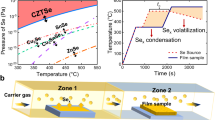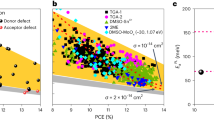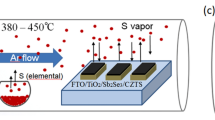Abstract
The control of the phase evolution during the selenization of kesterite Cu2ZnSn(S,Se)4 (CZTSSe) is crucial for efficient solar cells. Here, we regulate the phase-evolution kinetics of Ag-alloyed CZTSSe by applying a positive pressure in the reaction chamber at the initial stage of the annealing process. The partial pressure of Se decreases, reducing the collision probability between selenium molecules and the kesterite precursor during the initial formation of the crystals. This results in the precursor transforming into CZTSSe in a single step, without the formation of secondary phases. CZTSSe forms at relatively higher temperature than conventional methods, leading to high-crystallinity kesterite films with fewer defects. We demonstrate solar cells with a total area efficiency of 14.1% and a certified total area efficiency of 13.8%. This work provides insights into the selenization mechanism and phase evolution of kesterite absorbers, enabling efficient solar cells.
This is a preview of subscription content, access via your institution
Access options
Access Nature and 54 other Nature Portfolio journals
Get Nature+, our best-value online-access subscription
$29.99 / 30 days
cancel any time
Subscribe to this journal
Receive 12 digital issues and online access to articles
$119.00 per year
only $9.92 per issue
Buy this article
- Purchase on Springer Link
- Instant access to full article PDF
Prices may be subject to local taxes which are calculated during checkout





Similar content being viewed by others
Data availability
All data generated or analysed in this study are included in the published article, its Supplementary Information and Source data files. Source data are provided with this paper.
References
Gong, Y. et al. Elemental de-mixing-induced epitaxial kesterite/CdS interface enabling 13%-efficiency kesterite solar cells. Nat. Energy 7, 966–977 (2022).
Bourdais, S. et al. Is the Cu/Zn disorder the main culprit for the voltage deficit in kesterite solar cells? Adv. Energy Mater. 6, 1502276 (2016).
Kumar, M., Dubey, A., Adhikari, N., Venkatesan, S. & Qiao, Q. Strategic review of secondary phases, defects and defect-complexes in kesterite CZTS–Se solar cells. Energy Environ. Sci. 8, 3134–3159 (2015).
Gong, Y. et al. Sn4+ precursor enables 12.4% efficient kesterite solar cell from DMSO solution with open circuit voltage deficit below 0.30 V. Sci. China Mater. 64, 52–60 (2021).
Gang, M. G. et al. Sputtering processed highly efficient Cu2ZnSn(S,Se)4 solar cells by a low-cost, simple, environmentally friendly, and up-scalable strategy. Green. Chem. 18, 700–711 (2016).
Ge, J. et al. Investigation of Se supply for the growth of Cu2ZnSn(SxSe1−x)4 (x≈0.02–0.05) thin films for photovoltaics. Appl. Surf. Sci. 258, 7844–7848 (2012).
Zhao, Q., Shen, H., Sun, L. & Yang, J. Effect of selenium partial pressure on the performance of Cu2ZnSn(S, Se)4 solar cells. J. Mater. Sci. Mater. Electron. 31, 8662–8669 (2020).
Kumari, N., Kumar, J. & Ingole, S. Properties of Cu2ZnSnS4 films obtained by sulfurization under different sulfur-vapor pressures in a sealed ambient. Sol. Energy 231, 484–495 (2022).
Yin, K. et al. A high-efficiency (12.5%) kesterite solar cell realized by crystallization growth kinetics control over aqueous solution based Cu2ZnSn(S,Se)4. J. Mater. Chem. A 10, 779–788 (2022).
Márquez-Prieto, J. et al. Impact of the selenisation temperature on the structural and optical properties of CZTSe absorbers. Sol. Energy Mater. Sol. Cells 152, 42–50 (2016).
Xu, X. et al. Efficient and composition‐tolerant kesterite Cu2ZnSn(S, Se)4 solar cells derived from an in situ formed multifunctional carbon framework. Adv. Energy Mater. 11, 2102298 (2021).
Li, J. et al. Defect control for 12.5% efficiency Cu2ZnSnSe4 kesterite thin-film solar cells by engineering of local chemical environment. Adv. Mater. 32, 2005268 (2020).
Yin, X., Tang, C., Sun, L., Shen, Z. & Gong, H. Study on phase formation mechanism of non- and near-stoichiometric Cu2ZnSn(S,Se)4 film prepared by selenization of Cu–Sn–Zn–S precursors. Chem. Mater. 26, 2005–2014 (2014).
Giraldo, S. et al. How small amounts of Ge modify the formation pathways and crystallization of kesterites. Energy Environ. Sci. 11, 582–593 (2018).
Gong, Y. et al. Identifying the origin of the VOC deficit of kesterite solar cells from the two grain growth mechanisms induced by Sn2+ and Sn4+ precursors in DMSO solution. Energy Environ. Sci. 14, 2369–2380 (2021).
Mainz, R. et al. Phase-transition-driven growth of compound semiconductor crystals from ordered metastable nanorods. Nat. Commun. 5, 3133 (2014).
Son, D.-H. et al. Growth and device characteristics of CZTSSe thin-film solar cells with 8.03% efficiency. Chem. Mater. 27, 5180–5188 (2015).
Altamura, G. & Vidal, J. Impact of minor phases on the performances of CZTSSe thin-film solar cells. Chem. Mater. 28, 3540–3563 (2016).
Chernomordik, B. D. et al. Microstructure evolution during selenization of Cu2ZnSnS4 colloidal nanocrystal coatings. Chem. Mater. 28, 1266–1276 (2016).
Hages, C. J., Koeper, M. J., Miskin, C. K., Brew, K. W. & Agrawal, R. Controlled grain growth for high performance nanoparticle-based kesterite solar cells. Chem. Mater. 28, 7703–7714 (2016).
Su, Z. et al. Device postannealing enabling over 12% efficient solution-processed Cu2ZnSnS4 solar cells with Cd2+ substitution. Adv. Mater. 32, 2000121 (2020).
Zhou, J. et al. Regulating crystal growth via organic lithium salt additive for efficient kesterite solar cells. Nano Energy 89, 106405 (2021).
Gong, Y. et al. Ag incorporation with controlled grain growth enables 12.5% efficient kesterite solar cell with open circuit voltage reached 64.2% Shockley–Queisser limit. Adv. Funct. Mater. 31, 2101927 (2021).
Wang, J. et al. Ge bidirectional diffusion to simultaneously engineer back interface and bulk defects in the absorber for efficient CZTSSe solar cells. Adv. Mater. 34, 2202858 (2022).
Jimenez-Arguijo, A. et al. Small atom doping: a synergistic strategy to reduce SnZn recombination center concentration in Cu2ZnSnSe4? Sol. RRL 6, 2200580 (2022).
Son, D.-H. et al. Effect of solid-H2S gas reactions on CZTSSe thin film growth and photovoltaic properties of a 12.62% efficiency device. J. Mater. Chem. A 7, 25279–25289 (2019).
Hernández-Martínez, A. et al. Kinetics and phase analysis of kesterite compounds: influence of chalcogen availability in the reaction pathway. Materialia 24, 101509 (2022).
Mangan, T. C., McCandless, B. E., Dobson, K. D. & Birkmire, R. W. Thermochemical and kinetic aspects of Cu2ZnSn(S,Se)4 thin film growth by reacting Cu–Zn–Sn precursors in H2S and H2Se. J. Appl. Phys. 118, 065303 (2015).
Guo, H. et al. Optimization of the selenization pressure enabling efficient Cu2ZnSn(S,Se)4 solar cells. Sol. RRL 6, 2100778 (2021).
Gang, M. G. et al. Band tail engineering in kesterite Cu2ZnSn(S,Se)4 thin-film solar cells with 11.8% efficiency. J. Phys. Chem. Lett. 9, 4555–4561 (2018).
Jiang, J. et al. 10.3% efficient CuIn(S,Se)2 solar cells from DMF molecular solution with the absorber selenized under high argon pressure. Sol. RRL 2, 1800044 (2018).
Han, J. H. et al. Actual partial pressure of Se vapor in a closed selenization system: quantitative estimation and impact on solution-processed chalcogenide thin-film solar cells. J. Mater. Chem. A 4, 6319–6331 (2016).
Tan, J. M. et al. Understanding the synthetic pathway of a single-phase quarternary semiconductor using surface-enhanced Raman scattering: a case of wurtzite Cu2ZnSnS4 nanoparticles. J. Am. Chem. Soc. 136, 6684–6692 (2014).
Qu, Y., Zoppi, G. & Beattie, N. S. Selenization kinetics in Cu2ZnSn(S,Se)4 solar cells prepared from nanoparticle inks. Sol. Energy Mater. Sol. Cells 158, 130–137 (2016).
Dimitrievska, M. et al. Multiwavelength excitation Raman scattering of Cu2ZnSn(SxSe1−x)4 (0 ≤ x ≤ 1) polycrystalline thin films: vibrational properties of sulfoselenide solid solutions. Appl. Phys. Lett. 105, 031913 (2014).
Yannopoulos, S. N. & Andrikopoulos, K. S. Raman scattering study on structural and dynamical features of noncrystalline selenium. J. Chem. Phys. 121, 1167–1169 (2004).
Su, Z. et al. Fabrication of Cu2ZnSnS4 solar cells with 5.1% efficiency via thermal decomposition and reaction using a non-toxic sol–gel route. J. Mater. Chem. A 2, 500–509 (2014).
Suresh, S. & Uhl, A. R. Present status of solution‐processing routes for Cu(In,Ga)(S,Se)2 solar cell absorbers. Adv. Energy Mater. 11, 2003743 (2021).
Gilliland, E. R. Diffusion coefficients in gaseous systems. J. Ind. Eng. Chem. 26, 681–685 (1934).
Li, J. et al. Unveiling microscopic carrier loss mechanisms in 12% efficient Cu2ZnSnSe4 solar cells. Nat. Energy 7, 754–764 (2022).
Si, H. et al. A-site management for highly crystalline perovskites. Adv. Mater. 32, 1904702 (2020).
Dimitrievska, M. et al. Defect characterisation in Cu2ZnSnSe4 kesterites via resonance Raman spectroscopy and the impact on optoelectronic solar cell properties. J. Mater. Chem. A 7, 13293–13304 (2019).
Polman, A., Knight, M., Garnett, E. C., Ehrler, B. & Sinke, W. C. Photovoltaic materials: present efficiencies and future challenges. Science 352, 4424 (2016).
Yan, C. et al. Cu2ZnSnS4 solar cells with over 10% power conversion efficiency enabled by heterojunction heat treatment. Nat. Energy 3, 764–772 (2018).
Wang, W. et al. Device characteristics of CZTSSe thin-film solar cells with 12.6% efficiency. Adv. Energy Mater. 4, 1301465 (2014).
Shi, J., Li, D., Luo, Y., Wu, H. & Meng, Q. Opto-electro-modulated transient photovoltage and photocurrent system for investigation of charge transport and recombination in solar cells. Rev. Sci. Instrum. 87, 123107 (2016).
Shi, J. et al. From ultrafast to ultraslow: charge-carrier dynamics of perovskite solar cells. Joule 2, 879–901 (2018).
Li, Y. et al. Exploiting electrical transients to quantify charge loss in solar cells. Joule 4, 472–489 (2020).
Heath, J. T., Cohen, J. D. & Shafarman, W. N. Bulk and metastable defects in CuIn1−xGaxSe2 thin films using drive-level capacitance profiling. J. Appl. Phys. 95, 1000–1010 (2004).
Acknowledgements
Q.M. acknowledges funding from the National Natural Science Foundation of China (grant number U2002216). J.S. acknowledges funding from the National Natural Science Foundation of China (grant number 52222212). H.W. acknowledges funding from the National Natural Science Foundation of China (grant number 51972332). Y.L. acknowledges funding from the National Natural Science Foundation of China (grant number 52172261).
Author information
Authors and Affiliations
Contributions
The manuscript was written through contribution of all authors, and all authors have approved the final version of the manuscript. Q.M., H.X., D.L.: supervision, discussion, writing-review and editing. J.Z. and X.X.: experiments, simulation, characterization, writing-original draft. H.W.: discussion, Se partial pressure and IPCE measurement. J.W., L.L., K.Y., Y.G.: data analyses and discussion. J.S.: discussion, m-TPC/TPV analyses. Y.L.: data analyses.
Corresponding authors
Ethics declarations
Competing interests
The authors declare no competing interests.
Peer review
Peer review information
Nature Energy thanks Xiaojing Hao, Fangyang Liu and Jin-Kyu Kang for their contribution to the peer review of this work.
Additional information
Publisher’s note Springer Nature remains neutral with regard to jurisdictional claims in published maps and institutional affiliations.
Supplementary information
Supplementary Information
Supplementary Notes 1–8, Figs. 1–27, Tables 1–4 and Refs. 1–6.
Supplementary Data
Statistical source data.
Source data
Source Data Fig. 1
Statistical photovoltaic parameters.
Source Data Fig. 5
Unprocessed J–V curves and EQE data.
Rights and permissions
Springer Nature or its licensor (e.g. a society or other partner) holds exclusive rights to this article under a publishing agreement with the author(s) or other rightsholder(s); author self-archiving of the accepted manuscript version of this article is solely governed by the terms of such publishing agreement and applicable law.
About this article
Cite this article
Zhou, J., Xu, X., Wu, H. et al. Control of the phase evolution of kesterite by tuning of the selenium partial pressure for solar cells with 13.8% certified efficiency. Nat Energy 8, 526–535 (2023). https://doi.org/10.1038/s41560-023-01251-6
Received:
Accepted:
Published:
Issue Date:
DOI: https://doi.org/10.1038/s41560-023-01251-6
This article is cited by
-
Multinary alloying for facilitated cation exchange and suppressed defect formation in kesterite solar cells with above 14% certified efficiency
Nature Energy (2024)
-
Pd(II)/Pd(IV) redox shuttle to suppress vacancy defects at grain boundaries for efficient kesterite solar cells
Nature Communications (2024)
-
Highly efficient emerging Ag2BaTiSe4 solar cells using a new class of alkaline earth metal-based chalcogenide buffers alternative to CdS
Scientific Reports (2024)
-
Comparative study on the effects of substitutional Ag and substitutional Ge on kesterite thin-film solar cells
Applied Physics A (2024)
-
Single-phase evolution path to new record efficiency of kesterite solar cells
Science China Chemistry (2024)



